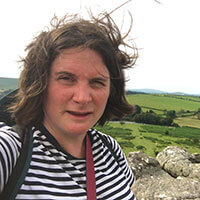We are all different. Some of those differences make it harder to exist in the world. Not being able to talk, or to walk, means that the world as it is can be a frustrating place. There are many more subtle differences to do with the way that our brains work. Some find busy crowds and loud noises intolerable, whilst others thrive when surrounded with people and immersed in action. Some learn to read very young and apparently without effort, for others it takes years and a more intentional approach.
The conventional way of seeing these differences is as disorders, particularly if they affect how a child performs in the education system. Those who are very different receive a diagnosis, which effectively says ‘Yes, this person is indeed different’. These diagnoses are given by psychiatrists or psychologists and are listed in a large psychiatric manual, the Diagnostic and Statistical Manual of Mental Disorders, or DSM. I have one on my shelf. Each diagnosis is a list of characteristics. If a person meets enough of the criteria, they get the diagnosis.
The idea that behavioural differences should be diagnosed is a medical solution to the problem of how to acknowledge and help people. In physical medicine, a diagnosis means that we have identified the cause of the problem. A diagnosis of COVID-19 means that we know why you are feeling ill, and therefore we can (hopefully) treat the virus rather than simply the symptoms. In mental health, it’s a bit different. There are few straightforward causes of the ‘mental disorders’ in DSM. A diagnosis of this type is description, not an explanation. The ‘symptoms’ are behaviour, or emotional reactions, and that’s really all we have. We might assume that there is an underlying cause, like a virus, but we don’t actually know that.
This doesn’t mean that a diagnosis is unnecessary, nor that it can’t help a person access help. It also doesn’t mean that some people don’t have very significant differences and challenges. It does mean that a diagnosis of ADHD or ASD isn’t the same as a diagnosis of COVID-19. It doesn’t tell us why something is happening. It isn’t the definitive way to understand a person’s behaviour, and there are some drawbacks to understanding behaviour in terms of ‘mental disorder’.
When a person is diagnosed with a disorder, it’s common for the people around them to behave as if that diagnosis explains their behaviour. Can’t sit still and concentrate at school? You might get a diagnosis of ADHD. Next time you can’t concentrate at school, someone will say, ah, that’s because you have ADHD. But the poor concentration was why you got the diagnosis in the first place, and the diagnosis is a description rather than an explanation – the reasoning becomes very circular.
You might be thinking, so what? The problem with this is that when we think we know the cause of something, we stop looking for other reasons. When a person has a diagnosis, we assume that the diagnosis is the reason for their behaviour, just like the virus causes COVID-19. With ADHD, the diagnosis turns the behaviour into a symptom. It can stop us from saying, hang on, maybe you can’t concentrate at school because it’s really boring. Maybe lots of children can’t concentrate and the others just make it less obvious. Maybe sitting still and concentrating just isn’t how many children learn best. Perhaps we should change the system!
Is there an alternative?
There are other ways of thinking about behaviour, which still acknowledge that people are different, and that these differences can make it more difficult to exist in our world.
Neurodiversity is the idea that people’s brains are different, and that these differences are not best viewed as disorders. Instead, they are just a way that someone is, right now.
Not just that, but neurodiversity focuses our attention on the way in which the environment interacts with a person’s differences. Let’s take the example of a child who does not learn to read until they are nine. In school, this is a big problem. That child will be in remedial lessons, they will be diagnosed with special educational needs and quite possibly dyslexia. Everyone will know that there is a problem. The child may well feel shame about their reading, and develop a sense of themselves as lacking in some way. A diagnosis provides some relief from this, which is one reason that people are keen to get them. If your problem is dyslexia, then it clearly isn’t your fault.
However, this isn’t so great for those who don’t get the diagnosis for whatever reason. How are they meant to think about themselves? Do we say that if you don’t get a diagnosis of dyslexia, then it is your fault that you can’t read yet? The diagnosis implies that some late reading is acceptable because it’s due to a diagnosable disorder but other late reading is not. It’s the same with other diagnoses. Having a diagnosis of ADHD means that now it’s understandable if you can’t concentrate – but that still implies that everyone else should be able to do so.
The diagnosis of dyslexia can function in the same way as that of ADHD, to stop us looking at the wider environment. If a child who doesn’t learn to read until they are nine is defined as ‘disordered’, then the system can continue unchanged whilst they get extra help. If instead we asked ourselves whether perhaps it’s part of the natural spectrum of development that not all children are ready to learn to read at age five or six, then we might conclude that adults need to change the education system to reflect just how diverse human development is. I would like to see us able to accept the full range of human diversity whether they have a diagnosis or not.
Among self-directed learners, late reading is not unusual. Children learn to read at ages ranging from 2-16, and they still become fluent readers. It doesn’t hold back a child’s other learning in the same way as it does at school. Children are not ranked against each other by their reading ability. It doesn’t need to create the same levels of shame and anxiety. There are many paths to reading.
So here we have a clear difference – age of learning to read – which is experienced entirely differently by the child and their family depending on whether they are in school or not. I’ve used reading because it’s easy to visualise, and because research by Harriet Pattison shows very clearly how different learning to read can be outside school. However, it applies to all sorts of neurodiversity. Children who develop on different schedules do not get on well to standardised norms.
This is where Self-Directed Education comes in. For the power of Self-Directed Education is that by allowing children to make choices about what they learn and how they learn it, they can choose what is most developmentally appropriate for them. This might mean watching preschool TV programmes for years, or only beginning to play imaginatively at age six or seven. It might mean playing mostly with adults and younger children, or interacting with peers only though a video game.
Creating a self-directed learning environment for some children is more challenging than others. The guiding principles need to be how a particular child learns best, and what they need right now. This requires a lot of flexibility from parents, and the idea that one-size-fits-all can be a problem even in Self-Directed Education. Children who struggle with social interactions, for example, may not enjoy free play groups which others love, and may instead prefer structure and regularity. Some children find that too much choice makes them very anxious, and their parents may need to be careful about how many opportunities they present. Some children need a lot of help to regulate their emotions, meaning that they need adults close by for longer.
With Self-directed Education, a child may learn things in an entirely different order to school. By not comparing them to their peers, we can allow their diversity to flourish and their strengths to be appreciated. This is very different to an approach which focuses on how children can ‘catch-up’ or learn to fit in. By celebrating each individual for who they are, Self-Directed Education allows them to learn to manage their differences, and to become able to seek out or create environments which work for them. And that is surely a worthwhile aim for the education of all our children.
If you enjoyed this article and feel called to give back to ASDE, here are ways you can support our work:
- Donate money
- Share our content with others! Click one of the buttons above to easily share on Twitter, Facebook, or email.
- Consider becoming a Contributor for Tipping Points
Tipping Points Magazine amplifies the diverse voices within the Self-Directed Education movement. The views expressed in our content belong solely to the author(s). The Alliance for Self-Directed Education disclaims responsibility for any interpretation or application of the information provided. Engage in dialogue by reaching out to the author(s) directly.






